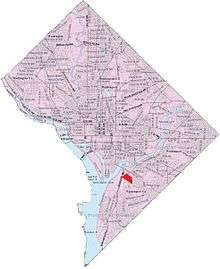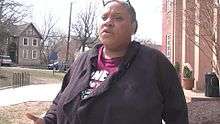Barry Farm

Barry Farm is a neighborhood in Southeast Washington, D.C., located east of the Anacostia River and is bounded by the Southeast Freeway to the northwest, Suitland Parkway to the northeast and east, and St. Elizabeths Hospital to the south. The neighborhood was renowned as a significant post-Civil-War settlement of free Blacks and freed slaves.[1] The streets were named to commemorate the Union generals and Radical Republicans who advanced the rights of black Americans during the Civil War and Reconstruction: Howard Road SE for General Oliver O. Howard; Sumner Road SE for Massachusetts Senator Charles Sumner; Wade Road SE for Ohio Senator Benjamin Wade; Pomeroy Road SE for Kansas Senator Samuel C. Pomeroy; and Stevens Road SE for Pennsylvania Congressman Thaddeus Stevens.[2] The neighborhood name is not a reference to the late former mayor of Washington, D.C., Marion Barry, but coincidentally has the same spelling.
History
In 1867, the Freedmen's Bureau (officially the U.S. Bureau of Refugees, Freedmen, and Abandoned Lands) bought a 375-acre farm from David and Julia Barry, white landowners, and transformed Barry Farm into a post-Civil War community of formerly enslaved and free-born African Americans.[3][4] Earlier, the Commissioner of the Freedmen's Bureau, General Oliver O. Howard, had asked African Americans squatting on land in Washington, D.C., what might help them to become self-supporting. They said, "Land! Give us land!" Howard promised to acquire land near the city. Howard transferred $52,000 from the refugees' and freedmen's fund to be held in trust by himself, Senator Samuel C. Pomeroy, and John R. Elvans for the use of three institutions: Howard University, Richmond Normal School, and St. Augustine Normal School in Raleigh. They used some of these funds to purchase Barry Farm. The Bureau sub-divided the farm into one-acre plots, which the freedmen could purchase over a period of seven years. For an additional $76, they could buy lumber to begin constructing a house. By 1869, money from the sale of the land, reportedly $31,178.12, had been returned to the fund and distributed to the three institutions listed above.[5]
Barry Farm was initially a large homestead, stretching all the way to 13th Street on the east, Poplar Point on the West, and the present-day Morris Road SE on the north. In 1871, the area between 13th Street, Sheridan Road, and Martin Luther King Jr. Avenue SE (then known as Nichols Avenue) was renamed Hillsdale. Railroad tracks laid around 1913 cut off Barry Farm from Poplar Point. In the early 1950s, the city built the Suitland Parkway, isolating the neighborhood between busy traffic arteries. Only a few old frame houses, mostly just at the edge of the thicket that separates Barry Farm from St. Elizabeths, are the remnants of the original Freedman's community.
The National Capital Housing Authority built the 432-unit Barry Farm Dwellings public housing project in 1943.[6] Some of the first tenants had been displaced by the construction of a military highway from Bolling Field to Camp Springs, MD.[7] Barry Farm has two to six bedroom apartments and a recreation center.[8]
Community life
Since 1975, Barry Farm has been the home to Barry Farms Community Basketball League. This summer league was renamed the Goodman League after community activist and Barry Farm Recreation Center counselor George Goodman.[9] The Goodman League features current and former NBA players, college players, and participants from various communities. The Barry Farm Beavers football team also plays at the recreation center.
In 1982, Barry Farm Dwellings residents, including Gladys Bunker, started a food co-op. The food co-op lasted for at least four years and accepted food stamps. Cornbread Givens and the Poor People's Development Foundation helped the co-op organizers.[10]
In 1997, the Capital Area Community Food Bank and Community Educational Economic Development worked with Barry Farm Dwellings residents to start a farm.[11]
Renowned residents
- Solomon G. Brown was the first African American employee at the Smithsonian Institution, serving for fifty-four years from 1852 to 1906.[12]
- Emily Edmonson (1835–1895), later Emily Johnson, was a founding member of the Hillsdale community. On April 15, 1848, she and her sister Mary were among the seventy-seven slaves who tried to escape from Washington, DC on the schooner The Pearl to sail up the Chesapeake Bay to freedom in New Jersey.
- The Junk Yard Band is a go-go band, founded in the early 1980s at Barry Farm Dwellings.
Proposed redevelopment
The DC Government seeks to completely demolish and redevelop Barry Farm through the city's New Communities Initiative and the Federal Choice program (the new Hope VI) from single-use public housing where 432 households pay 30% of their incomes to reside in the community, into a mixed-use, higher density community with 1,600 units including homes for sale. The land is adjacent to the Anacostia Metro Station. In 2013, about 50 Barry Farm residents teamed up with community organizing group Empower DC.[13] They formed the Barry Farm Tenants and Allies Association to stop the city from evicting them from their homes.

Resources
See also
- Anacostia
- List of public housing developments in the United States
- Public housing in the United States
References
- ↑ Cantwell 1976, p. 331.
- ↑ Muller, John. "Barry Farm street names reflect post-Civil War history". Greater Greater Washington.
- ↑ "Barry Farm Site, African American Heritage Trail". Cultural Tourism DC.
- ↑ Cantwell 1976, p. 338.
- ↑ Everly, Elaine Cutler (1971). The Freedmen's Bureau in the National Capital. PhD Dissertation, Department of History, The George Washington University.
- ↑ "The Barry Administration Reports to the People on Public Housing". GWU Special Collections, John A. Wilson Papers, MS2190, Box 8, File 2, "Housing legislation - ideas". June 1986.
- ↑ "NCHA Finds Homes for 99 Families: Groups Were Evicted To Make Way for New Bolling Field Military Road" (B1). Washington Post. Sep 10, 1943.
- ↑ "Barry Farm Recreation Center". DPR.
- ↑ "About The Goodman League". The Goodman League.
- ↑ Sugarman, Carole (December 10, 1986). "Gladys Bunker & the Fresh Ideal: Co-op Brings Fruit & Vegetables to Low-Income in Anacostia". The Washington Post.
- ↑ O'Neil, L. Peat (August 14, 1997). "In SW Tract, The Future Is Cultivated". The Washington Post.
- ↑ "Solomon Brown: First African American Employee at the Smithsonian Institution". Smithsonian Institution Archives.
- ↑ Milloy, Cortland (Oct 28, 2014). "Initiative to revitalize Barry Farm is little more than an urban dispersal plan". Washington Post.
Sources
- Cantwell, Thomas J. (1976). "Anacostia: Strength in Adversity". Records of the Columbia Historical Society of Washington, D.C. 1973-1974: 330-370. OCLC 5544040426.
External links
 |
Anacostia River |  | ||
| Naval Support Facility Anacostia | |
Buena Vista | ||
| ||||
| | ||||
| St. Elizabeths Hospital |
Coordinates: 38°51′33″N 76°59′57″W / 38.8593°N 76.9991°W